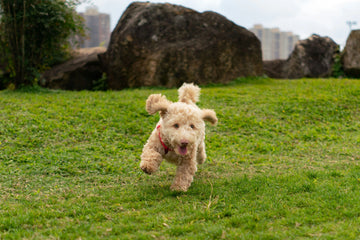As dogs enter their senior years, joint pain, stiffness, and reduced mobility often significantly impact their quality of life. Fortunately, with proper Joint Support for Elder Dogs, you can help your aging companion stay active, comfortable, and happy for many more years.
This comprehensive guide covers common joint issues in older dogs and offers evidence-based strategies—from dietary supplements to care tools and environmental adjustments—to deliver effective joint support for elder dogs.

Ⅰ. Understanding Joint Issues in Senior Dogs
Joint problems become more prevalent from around age 7, with conditions such as osteoarthritis, hip dysplasia, and degenerative myelopathy causing pain and reduced mobility.
Common signs indicating a need for joint support for elder dogs include:
-
Difficulty standing or slow movement
-
Hesitation to climb stairs or jump
-
Stiffer posture after rest
-
Notable muscle loss in hind legs
Proactive joint support for elder dogs can help delay progression and improve daily comfort.

Ⅱ. Supplements as the Foundation for Joint Support
Nutritional supplements are a key component in providing joint support for elder dogs. They work by supporting cartilage repair, reducing inflammation, and improving joint lubrication.
Evidence-backed ingredients:
-Glucosamine and Chondroitin: commonly used to support cartilage health, though clinical evidence is mixed. Some meta‑analyses show minimal benefit, especially depending on formulation quality.
-A recent randomized, placebo‑controlled study found that a multi‑ingredient formula (eggshell membrane, hyaluronic acid, Boswellia serrata extract, omega‑3 rich krill meal) improved pain, mobility, and quality of life in dogs with osteoarthritis over a 90‑day period.
-Green‑lipped mussel extract (Perna canaliculus) has demonstrated anti‑inflammatory and joint‑support benefits in dogs.
-Omega‑3 fatty acids (EPA/DHA) have been shown to reduce inflammation and improve gait in dogs with osteoarthritis.
While vitamin and supplement opinions vary among veterinarians, many experts support cautious use in senior dogs showing early signs of joint decline. Start a consistent regimen of joint supplements to form the basis of effective joint support for elder dogs.

Ⅲ. Mobility Aids to Reduce Stress on Aging Joints
Physical tools are essential when dogs begin showing mobility limitations. These items form a critical part of holistic joint support for elder dogs.
Recommended devices include:
-
Dog Lift Harness: Helps support your dog during activities like walking or stair climbing, relieving pressure from hips or knees.
-
Dog Wheelchair: Designed for dogs with hind limb weakness or paralysis, this restores movement and helps maintain muscle tone.
-
Dog Stairs or Ramps: Aid access to furniture or vehicles without jumping.
-
Anti-Slip Mats or Socks: Prevent slipping on smooth surfaces, thereby protecting hips and knees.
Integrating these mobility aids into daily life promotes safety, independence, and contributes to ongoing joint support for elder dogs.

Ⅳ. Low-Impact Exercise: Gentle Movement with Big Benefits
Senior dogs need low-impact movement—not complete rest—to maintain strength, flexibility, and joint health.
Recommended activities:
-
Hydrotherapy or swimming: Water supports body weight while engaging muscles and reducing joint strain.
-
Leisurely walks: Regular short walks aid in circulation and muscle steadiness.
-
Gentle stretching routines: Help maintain joint range and flexibility under professional guidance.
Regular, gentle exercise is a cornerstone of joint support for elder dogs, improving mobility while minimizing pain risk.
Ⅴ. Creating a Joint-Friendly Home Environment
Minor home modifications can significantly enhance comfort and mobility for aging dogs, as part of holistic joint support for elder dogs.
Environment tips:
-
Provide memory foam or orthopedic beds to cushion joints.
-
Install pet ramps or stairs beside furniture to reduce jumping.

-
Lay down non-slip mats on wood, tile, or slippery surfaces.
-
Keep essentials like food and water dishes at accessible height.
-
Use heated pads in cold weather to alleviate stiffness.
Together with other strategies, a supportive environment reinforces continuous joint support for elder dogs without relying solely on medication.
Ⅵ. Q&A: Everything You Should Know About Joint Support for Elder Dogs
Q1: Will joint support reverse joint damage?
A: It won’t “cure” existing conditions, but it can slow progression, reduce inflammation, and improve quality of life significantly.
Q2: When should I start joint support for elder dogs?
Start proactively around age 7, or earlier for large breeds. Preventative joint support delays deterioration and maintains mobility longer.
Q3: Is joint support only for dogs in pain?
No. Many dogs hide pain well. Signs like slowing down, hesitation to jump, or avoiding stairs are all indicators that joint support for elder dogs is needed—even before visible limping begins.

Getting older is inevitable—but suffering isn’t. With proper joint support for elder dogs, you can give your loyal companion a pain-free, mobile, and fulfilling life.
Start today: Whether it’s supplements, tools like lift harnesses or ramps, or creating a joint-friendly home, your dog will thank you—with every happy, pain-free step they take.
This article is for informational purposes only and is not a substitute for professional veterinary advice.





